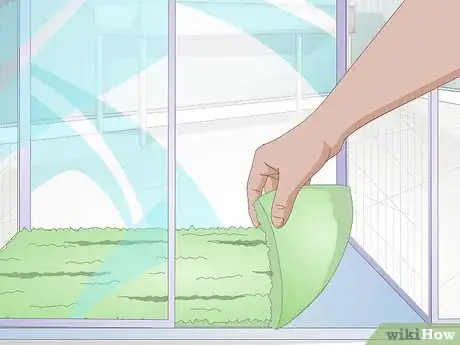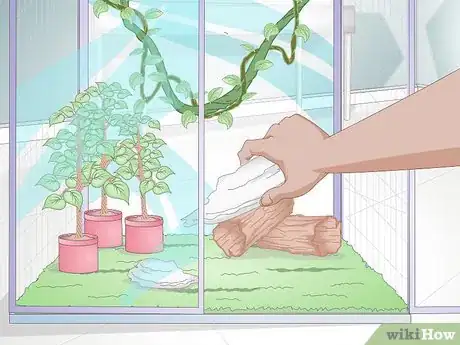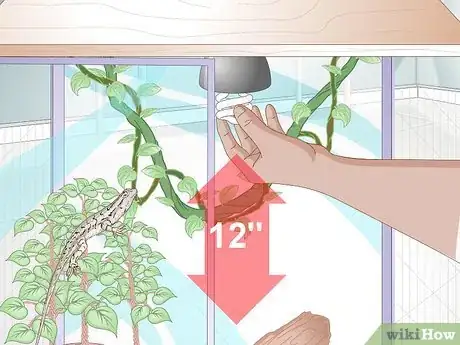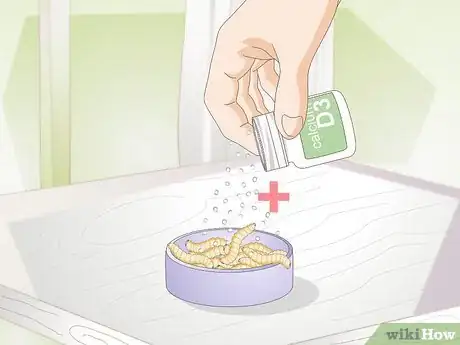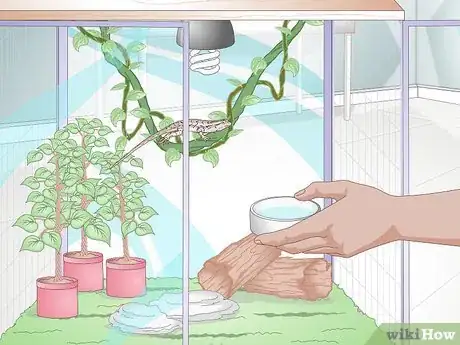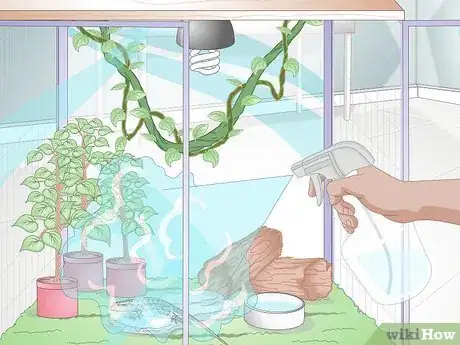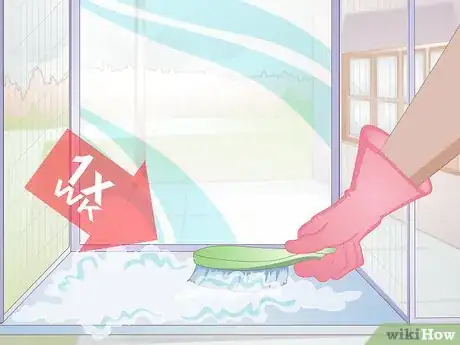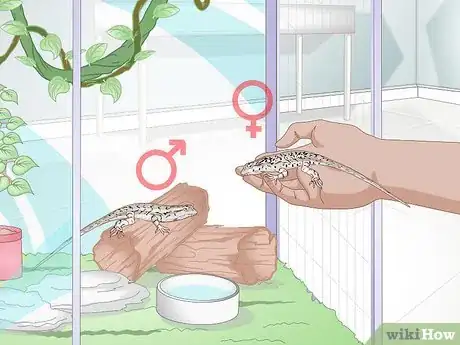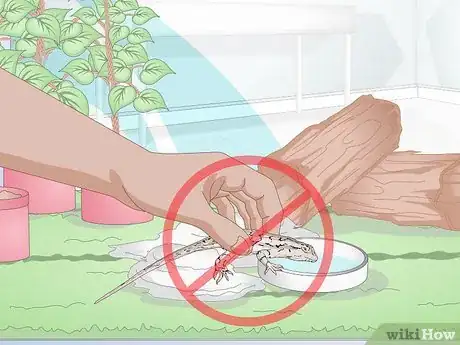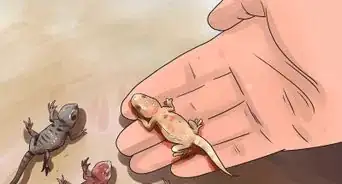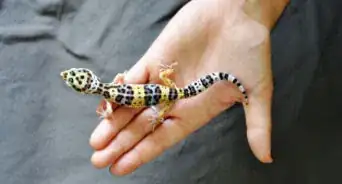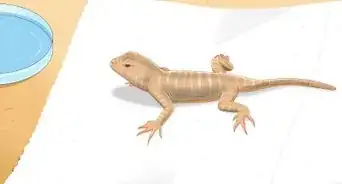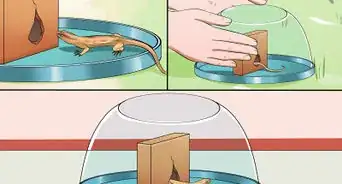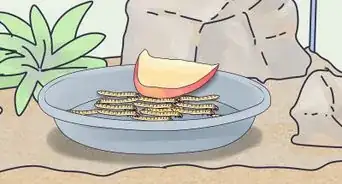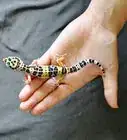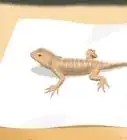This article was co-authored by Jeff Jensen. Jeff Jensen is a Reptile Specialist and the Owner of The Reptile Zone out of Bend, Oregon. With decades of experience with reptiles and wildlife, Jeff specializes in providing advice and guidance on proper reptile care. As a former science teacher and employee of the San Antonio Zoo and an accomplished herpetologist, Jeff’s dedication to knowledge and ethical pet trade practices led to The Reptile Zone being awarded a “Mark of Excellence” Award by Intrepid Marketing in 2018.
There are 10 references cited in this article, which can be found at the bottom of the page.
wikiHow marks an article as reader-approved once it receives enough positive feedback. This article received 14 testimonials and 100% of readers who voted found it helpful, earning it our reader-approved status.
This article has been viewed 159,398 times.
The Texas spiny lizard is a fairly common yet beautiful lizard inhabiting the drier regions of southern North America. Though not typically sold commercially, if you live in Texas, it’s possible to find Texas spiny lizards in a pet store or even catch one for yourself. Texas spiny lizards make great pets since they adapt well to captivity and eat a diet of readily available insects. If you provide your Texas spiny lizard with a large cage, ample play space, a good source of heat lighting, and a balanced diet, you will have a wonderful pet for around seven years.
Steps
Creating a Suitable Habitat for a Texas Spiny Lizard
-
1Purchase a large cage. Texas spiny lizards are active creatures that grow to about 7.5” to 12”. They need a large cage that accommodates their size and provides them with plenty of space to run around. They are also arboreal, meaning they need to climb. Get a 20 to 30 gallon cage or terrarium and make sure you’ll have room for plants, logs, and vines for your lizard to play with.[1] [2]
- Be sure the cage is enclosed so that the lizard doesn’t escape.
-
2Cover the bottom with cage carpet. To cover the bottom of the cage, you can use either cage carpet, sand, small rocks, or powdered walnut shell. Cage carpet is generally recommended, however, as lizards might consume alternative floor types, which can lead to digestive issues.[3]
- Cage carpet can be a bit trickier to clean. Make sure to give yourself some time every month to dedicate to keeping your lizard’s cage carpet in good condition.
- Cage carpet can be purchased online at PetSmart or Amazon. Call your local pet store to see if they sell cage carpet.
Advertisement -
3Add plants to the terrarium. Plants will make your lizard feel more at home in its terrarium, and also give the lizard something to climb in. Put as many plants, vines, branches, and sticks that you can in the cage so that your lizard will have ample climbing material.[4]
- While it’s okay to put live plants, vines, and branches into your lizard’s home, be sure they don’t carry too much moisture. The Texas spiny lizard prefers a drier environment. It’s best to put a mixture of live and fake climbing surfaces into the cage.[5]
- If you find plants outside, make sure they are free of bugs and are not poisonous.[6]
- One of the Texas spiny lizard’s hobbies is digging into decayed logs. Put a piece of an old log into the cage once every few weeks to give the lizard a nice activity.
-
4Provide a hiding place. Lizards like to have a place to hide themselves every so often. Add a log that can accommodate the length of your lizard to the cooler side of the cage. Remember that Texas spiny lizards grow to about 12”.[7]
- It’s best to get a hollowed out log so that your lizard can hide completely. You can buy a hollowed out log at most pet stores. If you’re handy, make one yourself![8]
- You’ll also want to have a part of the cage left open for the lizard to play in. Try to put this on the opposite side of the cage from the hiding spot.
-
5Give your lizard ample light. Texas spiny lizards are diurnal and like to bask in the sun, so will need full spectrum UVB cage lighting to stay healthy and happy. You’ll want the cage to be between 80-88 degrees during the day, 70–80 degrees at night, and 100-108 in the lizard’s basking spot.[9]
- Make a basking platform around 12 inches from the basking light. The UVB rays aren’t strong enough to be placed any farther away from the lizard.[10]
- Only put lighting on one side of the cage since your lizard needs a cool place as well.
- Ask about how to properly set up cage lighting at a local pet store to ensure your lizard’s health and safety.
Feeding the Texas Spiny Lizard
-
1Feed your lizard a mix of insects. Texas spiny lizards require a diet of live insects, and will thrive if you provide them with a variety of species. Giant mealworms, crickets, regular mealworms, silkworms, and non-noxious caterpillars are all great choices.[11]
- Feed your lizard once a day. If your lizard is active and healthy, feed them as much as they can eat over a 15-20 minute time period. If they are overweight, talk to a vet about a diet plan that will keep your lizard healthy.[12]
- Be sure that the insects are relatively small in comparison to the lizard’s head. Otherwise the lizard may suffer digestive problems. Cut the insects yourself if the pieces seem too large.
- If you live near fields or meadows that are not sprayed with insecticides, you can collect your own insects (known as “field plankton”) with a sweep net during warmer months.[13]
- Remove any uneaten insects from the cage immediately after feeding.[14]
-
2Dust food with vitamin D3 and calcium powder. To ensure that your lizard is getting proper nutrients, dust its food once a week or every other week with vitamin D3 and calcium powder.[15]
- You can purchase Rep-Cal Reptile Calcium Powder with D3 online at either PetSmart or Amazon.
- To dust the insects, place the insects and a little bit of dusting powder in a glass jar and shake until the insects are coated with the powder. Then feed to your lizards immediately.
-
3Change the water regularly. Provide fresh water for your lizard in a shallow dish. Be sure to change the water every day to keep your lizard healthy.
- If the water splashes around too much you’ll have to clean the substrate to keep the habitat dry.[16]
-
4Mist the cage. Buy a mist spray bottle and mist your lizard’s cage twice a week. Lizards like to lick water off plants, and misting the plants and vines in your cage will give them extra opportunity to hydrate. Don’t drench the cage as the habitat substrate needs to stay dry. Instead, lightly mist any surfaces that your lizard likes to climb or play on.[17]
Caring For the Texas Spiny Lizard
-
1Clean the cage. Clean the cage thoroughly once a week. This is an involved procedure that will take some time. You will need rubber gloves, disinfectant, and hot, soapy water for cleaning. You should also check daily for spilled food, feces, or other hazardous particles. [18]
- First, remove your lizard from the cage and place in a safe spot while you clean.
- Remove all decorations from the cage and clean with hot, soapy water.
- Clean the food and water bowls with hot, soapy water. For a homemade cleanser, mix 1 teaspoon (5 ml) dishwashing detergent (such as Palmolive® or Dawn®) and 1 ounce (30 ml) of household bleach into 1 quart of water.
- Clean cage surfaces with hot, soapy water. Then clean again with a disinfectant. For disinfectant, use a bleach solution containing 1 part bleach to 16 parts water.[19]
- Let the cage dry before replacing decorations, food bowls, and the lizard.[20]
-
2Provide proper cage mates. Texas spiny lizards are perfectly happy to be alone in a cage, but if you do decide to have more than one in a cage, make sure you pair them correctly. You should never have two male spiny lizards in the same cage. However, two females will get along well in the same space.[21]
- If you put a male and female together in a cage, they will likely breed.
-
3Don’t pick up your lizard. Texas spiny lizards should be treated as a display species. They don’t like to be picked up and held. If you hold them for too long and try to play with them they are likely to bite. Only handle your lizard when necessary, such as during cage cleanings.[22]
- If you must pick up the lizard for a cage cleaning, use your palm and fingers to cup the lizard's body from its neck to its cloaca, or neck vent. Then, gentle lift up the lizard in one fluid motion. Do not hold the lizard by its tail as the tail can break off.
Community Q&A
-
QuestionHow often should a 2-3" Texas spiny lizard eat in a day or a week?
 Community AnswerYour Texas spiny lizard should be fed a diet of insects every day.
Community AnswerYour Texas spiny lizard should be fed a diet of insects every day. -
QuestionHow can I tell the gender of a Texas spiny lizard? Any specific markings?
 Community AnswerA female has a V slit for the rectum. A male will have a straight line for the rectum. The males are sometimes bigger and darker, too.
Community AnswerA female has a V slit for the rectum. A male will have a straight line for the rectum. The males are sometimes bigger and darker, too. -
QuestionHow big do they grow
 Community AnswerAdult Texas spiny lizards reach bewteen 7.5" and 12".
Community AnswerAdult Texas spiny lizards reach bewteen 7.5" and 12".
Warnings
- Never release your pet into the wild even if you know your lizard's species is native to your area.⧼thumbs_response⧽
- As with all animals, Texas spiny lizards are able to bite when threatened. Take care not to injure the lizard if it bites.⧼thumbs_response⧽
References
- ↑ http://www.reptilesmagazine.com/Care-Sheets/Blue-Spiny-Lizard-Care-Sheet/
- ↑ http://www.pet-lizard.com/texas-spiny-lizard.html
- ↑ http://www.pet-lizard.com/texas-spiny-lizard.html
- ↑ http://www.pet-lizard.com/texas-spiny-lizard.html
- ↑ http://www.petplace.com/article/reptiles/general/housing-caging-your-reptile/housing-your-lizard
- ↑ http://www.petplace.com/article/reptiles/general/housing-caging-your-reptile/housing-your-lizard
- ↑ http://www.reptilesmagazine.com/New-Owner/Herp-Hides/
- ↑ http://www.reptilesmagazine.com/New-Owner/Herp-Hides/
- ↑ http://www.reptilesmagazine.com/Care-Sheets/Blue-Spiny-Lizard-Care-Sheet/
- ↑ http://www.reptilesmagazine.com/Care-Sheets/Blue-Spiny-Lizard-Care-Sheet/
- ↑ http://www.reptilesmagazine.com/Care-Sheets/Blue-Spiny-Lizard-Care-Sheet/
- ↑ http://www.thebeardeddragon.org/leopard-gecko/leopard-gecko-diet.php
- ↑ http://www.reptilesmagazine.com/Care-Sheets/Blue-Spiny-Lizard-Care-Sheet/
- ↑ http://www.thebeardeddragon.org/leopard-gecko/leopard-gecko-diet.php
- ↑ http://www.thebeardeddragon.org/leopard-gecko/leopard-gecko-diet.php
- ↑ http://www.reptilesmagazine.com/Care-Sheets/Blue-Spiny-Lizard-Care-Sheet/
- ↑ http://cnmtechsolutions.wix.com/thriftypets#!spiny-lizard/csjg
- ↑ http://www.peteducation.com/article.cfm?c=17+1796&aid=2847
- ↑ http://www.drsfostersmith.com/pic/article.cfm?aid=823
- ↑ http://www.peteducation.com/article.cfm?c=17+1796&aid=2847
- ↑ http://cnmtechsolutions.wix.com/thriftypets#!spiny-lizard/csjg
- ↑ http://www.reptilesmagazine.com/Care-Sheets/Blue-Spiny-Lizard-Care-Sheet/
About This Article
To care for a Texas spiny lizard, buy a 20 to 30 gallon cage or terrarium so the lizard will have room to grow and move. Additionally, cover the bottom of the cage with carpet, sand, small rocks, or powdered walnut shells. You should add plants, vines, and branches to the cage for ample climbing material, and a full spectrum UVB cage light to keep your lizard warm and happy. In order to feed your lizard, provide it with a variety of live insects once a day, such as meal worms, crickets, and silkworms. To learn how to provide your lizard with proper cage mates, keep reading!
